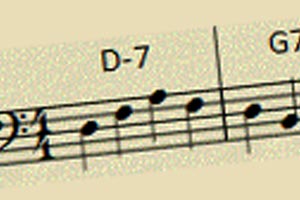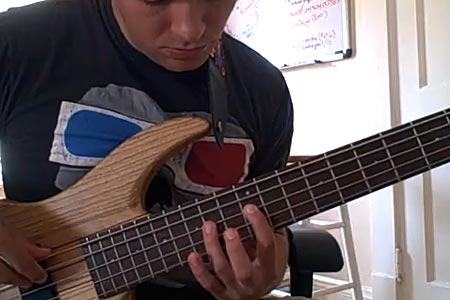Bass Lessons - Page 38
The Zen of Ear Training – Part 2
In the last lesson we covered a few different strategies for starting to train your ears. This included singing with your instrument, singing over a drone, and singing intervals in all the keys. Now we’re going to take it a few steps further and work to really develop our ears ability to pick out notes and relationships. Remember that these...
Melodic Construction: Extensions on Dominant Chords, Part 1
We know that there are many flavors of dominant chord. Various upper extensions of the chord—or alterations of the fifth—suggest different harmonic environments, each with its own chordal scale and triad polychords expressing the arrays of extensions. We’ll explore the most commonly used of these chords and extensions in a future column—but first… What do these extensions mean for the...
The Zen of Ear Training – Part 1
An important part of every musician’s evolution is ear training. It’s a strange concept, but becoming an active and educated listener pays off in a huge way. First lets cover a few points about what ear training is and isn’t and then we’ll get to the exercises. Ear training is a broad term used to cover two aural developmental practices...
Lesson: Fingering strategies for the upright bass
The upright bass is a physically challenging instrument. I’m not trying to say we’re tougher than our treble-ended friends, but when was the last time you saw a violinist shift three feet at a time? The size of the upright bass means we have to be very efficient in how we approach playing music, especially if you are going to...
Lesson: Pivots in Chord Inversions
We’ve talked in previous columns about anchors and pivots occurring primarily on roots and fifths. What do we use for pivots in the case of chord inversions? We often see these inversions and other sorts of alternate bass notes in the form of compound chord symbols: C/Bb Bb/A Db/F Ebmin/Gb Go/C etc In these chords, there is a triad over...
Lesson: Melodic 2-5-1 Mutation
In one of my earlier lessons I talked about using melodic minor scales to create different degrees of altered tension over functional dominant seventh chords. I got a request from a No Treble reader named Mark, asking for ii-V-I applications. Mark, this lesson is for you! We’re going to focus on different ways to reharmonize the ii-V-I and how that...
To click or not to click? Or, what’s in a metronome?
All musicians benefit from practice with a metronome, yet many, if not most, musicians tend to avoid it some or all the time. The metronome can feel like a scolding tyrant reminding us of our incompetence, or maybe we want to get through our work quickly without the discipline of methodical practice, or maybe we believe that the metronome is...
Lesson: Pulse and Escaping from Meter
As bassists we have unique musical responsibilities in an ensemble whether it’s a symphony, jazz jam or rock group. We’re the foundation – the pulse. There is a pitfall that we must be careful to avoid and it’s ingrained in us through a lot of standard music education: we are bound by meter and notation. If you had to could...
Lesson: Stance on the Upright Bass
In this week’s lesson, Jon takes us through some key fundamentals in upright bass playing. Balance Balance is the key. It takes many pounds of pressure to hold a string against the fingerboard with enough firmness to get a good fundamental tone; this force needs to have a counterweight applied against it. The objective is to get maximum weight into...
Thinking in Minor: Alterations
In the previous lesson I talked about using melodic minor arpeggios to change the sound of an underlying chord structure. This lesson will take that concept a step further and focus on identifying functioning and static dominant seventh chords and how to apply the melodic minor scale in various ways to control multiple degrees of tension. This will also lend...
Lesson: By the Numbers
There are 2 elements that are helpful to gain fluency in all keys, making transposition much easier. The first is, learn fingerings avoiding open strings as much as possible, so that interval and visual mapping is consistent. The other is to learn to think by the numbers; think of each pitch not as its letter name, but as its numerical...
Lesson: Thinking in Minor
The minor keys offer a diverse sonic palette for you to use in improvisation. The darker quality of the tonal sequence gives you a cool sound and the minor keys are very versatile over different chord changes. This lesson will focus on some basic applications of minor keys in different scenarios so you can start to use these keys effectively....



